|
|
Nissan Skyline V36 /
Infiniti
G-series
Debut: 2006
Maker: Nissan
Predecessor: Skyline V35 / Infiniti G-series |
|
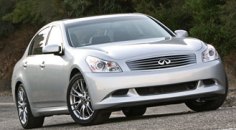 4
years after launch, Nissan Skyline / Infiniti G35 has received a major
update and a new codename V36. This update concentrates on 3 areas: 1)
power, 2)
handling and 3) interior quality. The objective is to close the gap
from class-leader BMW 3-Series. 4
years after launch, Nissan Skyline / Infiniti G35 has received a major
update and a new codename V36. This update concentrates on 3 areas: 1)
power, 2)
handling and 3) interior quality. The objective is to close the gap
from class-leader BMW 3-Series.
Outside, the Skyline / G35 is not a big departure from the outgoing
car. The facelifted nose and tail are more flowing and more dynamic,
but its organic shape started looking tired. It lacks the elegance of
Audi and Lexus. Even compare with the strange-looking 3-Series, it
feels rather bulky. Size-wise, yes, the Nissan remains to be the
largest in its class, thanks to the 2850mm wheelbase (3-Series: 2760mm;
A4: 2648mm; IS350: 2730mm), but its interior volume is not used very
efficiently. In fact, rear headroom has been reduced slightly owing to
a faster roofline. Passengers over 6 feet won't fit there comfortably.
Our biggest complaint for the old car was the horribly cheap interior
packaging. In the new car, Nissan has partly sorted out the problem by
redesigning the whole dashboard and console and by using higher grade
plastics. Still, this is not a beautiful design, and there is still a
feeling of built to costs. To match the aforementioned rivals, it
should employ even higher quality plastics and switch gears, and fit
them more solidly in place. Noise insulation and ride quality over
small imperfections also need to be improved.
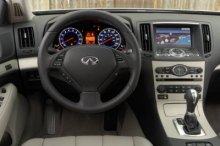 Okay,
refinement is not the strongest suit of Skyline / G35, old or new. Its
trump card is driver appeal instead. This must thanks to the strong
engine and strong chassis. Nissan has updated the VQ series engine to
the 4th generation. Now codenamed VQ35HR – in which the HR represents
High Revolution – it can spin to 7500 rpm, up from 6600 rpm. This is
contributed by the addition of exhaust VVT (continuous type and
actuated by electromagnetic like Lexus LS460), smoother exhaust and
higher 10.6:1 compression made possible by improved knock control and
water cooling. The result is 306 horsepower at 6800 rpm, same value as
Lexus IS350, and a max torque of 268 lbft available at 5200 rpm. The
latter is not as brilliant as Lexus though. Infiniti claims lower fuel
consumption than the outgoing car, but you won't expect much
improvement because this engine still comes without direct injection. Okay,
refinement is not the strongest suit of Skyline / G35, old or new. Its
trump card is driver appeal instead. This must thanks to the strong
engine and strong chassis. Nissan has updated the VQ series engine to
the 4th generation. Now codenamed VQ35HR – in which the HR represents
High Revolution – it can spin to 7500 rpm, up from 6600 rpm. This is
contributed by the addition of exhaust VVT (continuous type and
actuated by electromagnetic like Lexus LS460), smoother exhaust and
higher 10.6:1 compression made possible by improved knock control and
water cooling. The result is 306 horsepower at 6800 rpm, same value as
Lexus IS350, and a max torque of 268 lbft available at 5200 rpm. The
latter is not as brilliant as Lexus though. Infiniti claims lower fuel
consumption than the outgoing car, but you won't expect much
improvement because this engine still comes without direct injection.
However, the power and refinement of the VQ is already impressive
enough. On the one hand it can propel the car from rest to 60 mph in a
little more than 5 seconds. On the other hand it spins smoothly up to
redline, even more so than the old VQ, thanks to a strengthened engine
block. Mating with the V6 is either a 5-speed paddle-shift automatic or
a 6-speed manual (for Infiniti G35 Sport only), both have satisfyingly
smooth gearshift.
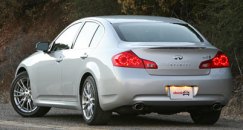 The
chassis has received 40 percent increase of rigidity thanks to more
spot welding and laser seam welding. The stiffer chassis allows firmer
spring and damper setting, especially in G35 Sport. Front and rear
tracks have been widened slightly. Front to rear balance remains 53:47,
but the engine is now mounted 15mm lower. New viscous coupling limited
slip differential helps hard cornering. Besides, the Skyline has 4WS
(4-wheel-steering) returned as optional equipment, which steer the rear
wheels by up to 1 degree according to steering input and speed.
However, the benefit of 4WS is not obvious according to road testers. The
chassis has received 40 percent increase of rigidity thanks to more
spot welding and laser seam welding. The stiffer chassis allows firmer
spring and damper setting, especially in G35 Sport. Front and rear
tracks have been widened slightly. Front to rear balance remains 53:47,
but the engine is now mounted 15mm lower. New viscous coupling limited
slip differential helps hard cornering. Besides, the Skyline has 4WS
(4-wheel-steering) returned as optional equipment, which steer the rear
wheels by up to 1 degree according to steering input and speed.
However, the benefit of 4WS is not obvious according to road testers.
In terms of handling, 3-Series is still safely at the top, but Skyline
/ G35 has become a close second. It can easily outgun Lexus and Audi.
We won't have opportunity to see it testing against Alfa Romeo 159
until at least 2009, but it seems that will be a close fight. One thing
might not favour the Nissan is: its speed-sensitive power steering
continues to feel numb, and the change of weighting is slow and
artificial.
As a driver's car, Skyline / G35 has come very close to the top level.
What a pity the tight cost control of Nissan prevents it from feeling
like a really premium car. The update is successful, but it
won't change the "second division" image of the car.
|
| The
above report was last updated on 4 Oct 2006. All Rights Reserved. |
|
Skyline Coupe / Infiniti G37 Coupe
|
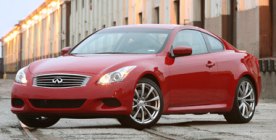 When Nissan introduced the pre-production
G37 Coupe to the press in March 2007, it brought a BMW 335i Coupe for
them to compare side by side on a test track. Until then, 335i was the
benchmark of the class and nobody else could come close to its perfect
combination of performance, handling and refinement. Apparently, Nissan
was confident to beat the great BMW, otherwise it would not have
brought the car there. In the end of the day, none of the American
journalists came home without praising the G37 and declaring it beating
the 335i. When Nissan introduced the pre-production
G37 Coupe to the press in March 2007, it brought a BMW 335i Coupe for
them to compare side by side on a test track. Until then, 335i was the
benchmark of the class and nobody else could come close to its perfect
combination of performance, handling and refinement. Apparently, Nissan
was confident to beat the great BMW, otherwise it would not have
brought the car there. In the end of the day, none of the American
journalists came home without praising the G37 and declaring it beating
the 335i.
What made Nissan so confident ? This starts from the handsome design,
extends to the 36 percent-stiffer chassis (compare with the old G35
Coupe) and
the new VQ37VHR engine. The latter is definitely the highlight of the
car. Compare with the VQ35HR used in the G35 sedan, VQ37VHR added not
only 200 cc of capacity through longer stroke but also a higher
compression ratio (11.0:1) and a continuously variable intake valve
lift system called VVEL (Variable Valve Event and Lift). The latter
sounds like BMW's Valvetronic, but its mechanism is significantly
lighter, smaller, involves less parts and therefore allows the engine
to rev to as high as 7500 rpm, equaling the shorter-stroke VQ35HR. It
produces 330 horsepower at 7000 rpm, 24hp more than the G35 sedan.
Strangely, the max torque barely increases from 268 lbft to 270 lbft at
5200 rpm despite of the increased stroke, implying the engine is tuned
for high-end power.
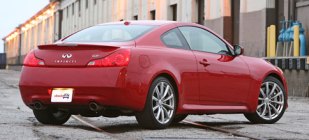 On
paper, the Infiniti has everything to beat the BMW. Its chassis is
lower and wider, suggesting better handling. If that's not enough, it
has bigger brakes inside the larger 19-inch wheels, a limited slip
differential and optional electronic-controlled 4-wheel-steering
(4WAS). It has an advantage of 30 horsepower and, ridiculously, its
high-revving naturally aspirated V6 conforms to the traditional
philosophy of BMW more than the twin-turbo six of 335i. In other words,
more BMW than BMW. On
paper, the Infiniti has everything to beat the BMW. Its chassis is
lower and wider, suggesting better handling. If that's not enough, it
has bigger brakes inside the larger 19-inch wheels, a limited slip
differential and optional electronic-controlled 4-wheel-steering
(4WAS). It has an advantage of 30 horsepower and, ridiculously, its
high-revving naturally aspirated V6 conforms to the traditional
philosophy of BMW more than the twin-turbo six of 335i. In other words,
more BMW than BMW.
Unfortunately,
when journalists finally drove the production car in late June, their
findings were very different from the first impression. This time most
people found it didn't really match 335i Coupe. First of all, the BMW's
twin-turbo engine feels far more powerful in real world, thanks to its
superior bottom end and mid-range torque. VQ37VHR might deliver a
little
more horses at the top end, but it is neither as smooth nor as melodic
as the BMW engine. Couples to the fact that G37 Coupe carries some 140
kilograms more than its rival, it takes an extra 0.4 seconds to do 0-60
mph and as much as 1.1 seconds more to do 0-100 mph sprint, according
to the measurement conducted by Car and Driver. In short, 335i knocks
out G37 in engine and performance convincingly.
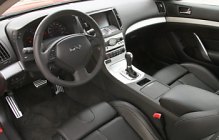 Other
aspects are similar. While it matches 335i for body control and comes
very close in ride quality, most of its controls lack the fine
polishing of BMW – the steering feels numb, the gearshift is a little
notchy, the clutch
too heavy and abrupt, the brake feels vague and braking performance is
no where as good as the lighter BMW. These qualities separate a
fine car from a great car. Turn into corners, the G37
understeers a little more than the BMW as well as its predecessor
G35 Coupe. It becomes more civilized and, inevitably, delivers less fun. Other
aspects are similar. While it matches 335i for body control and comes
very close in ride quality, most of its controls lack the fine
polishing of BMW – the steering feels numb, the gearshift is a little
notchy, the clutch
too heavy and abrupt, the brake feels vague and braking performance is
no where as good as the lighter BMW. These qualities separate a
fine car from a great car. Turn into corners, the G37
understeers a little more than the BMW as well as its predecessor
G35 Coupe. It becomes more civilized and, inevitably, delivers less fun.
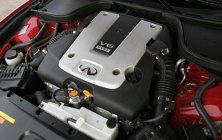 Can
the optional 4WAS system save it from losing ? Sadly, Nissan's
engineers forgot how to make a 4-wheel-steering system work like the
old Skyline GT-R. In the G37, the system actually introduces even more
understeer and makes the steering more unpredictable. In other words,
it is a waste of money. Can
the optional 4WAS system save it from losing ? Sadly, Nissan's
engineers forgot how to make a 4-wheel-steering system work like the
old Skyline GT-R. In the G37, the system actually introduces even more
understeer and makes the steering more unpredictable. In other words,
it is a waste of money.
Talking about money, the G37 is cheaper than
335i Coupe, of course, but the latter's superior dynamics, precision,
refinement, cabin space and build quality worth even more money. In
isolation, G37 is a fine coupe, but to beat the Bimmer it still has a
long long way to go.
What we can learn from this lesson is never to trust a car maker who
generously offers a rival product for comparison, especially on a test
track selected by the car maker. A fair comparison should be conducted
on a variety of roads and on production cars without "special
treatment". You know what I mean.
|
| The
above report was last updated on 5 Jul 2007. All Rights Reserved. |
|
Skyline 3.7 / Infiniti G37
|
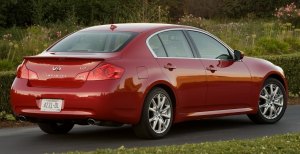 Following
Infiniti G37 Coupe, the sedan
version has also been upgraded to 3.7-liter engine, hence a new
designation G37. This version also signals the first wave of Infiniti
invasion into European market. At the moment of writing, the Japaense
Skyline sedan has not been updated yet. However, there is no reasons to
offer two different engines to different markets, so we expect Skyline
will also get the 3.7 upgrade soon. Following
Infiniti G37 Coupe, the sedan
version has also been upgraded to 3.7-liter engine, hence a new
designation G37. This version also signals the first wave of Infiniti
invasion into European market. At the moment of writing, the Japaense
Skyline sedan has not been updated yet. However, there is no reasons to
offer two different engines to different markets, so we expect Skyline
will also get the 3.7 upgrade soon.
The VQ37VHR engine has slightly higher capacity and a variable valve
timing and lift system (VVEL)
to generate some 328 horses at 7000 rpm and 269 lb-ft at 5200 rpm. It
makes the car even faster, although it still cannot match the lighter
and torquer BMW 335i. Another noticeable improvement is the engine's
NVH suppression, now closer to the best German engines. As before, keen
drivers may choose the 6-speed manual gearbox whose shift quality has
been improved. Lazier drivers gets a new 7-speed automatic gearbox,
with 2 ratios more than before to enhance fuel economy and
acceleration. Overall speaking, G37 sedan is a small and predictable
improvement from G35.
|
| The
above report was last updated on 3 Oct 2008. All Rights Reserved. |
|
IPL G Coupe
|
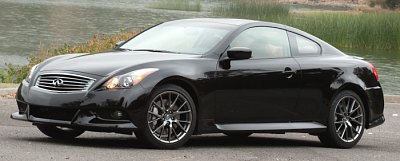
|
Hottest G Coupe is still 70hp down on
M3...
|
The new IPL nameplate,
which stands for Infiniti Performance Line, seems to finally give the
Japanese premium brand a performance rival to BMW M-cars, Mercedes AMG
and Audi S-line. Sadly, what we found in IPL's first product, IPL G
Coupe, is only a mild tuning based on the G37 Coupe. In particular,
performance boost is disappointing. Nissan did not touch the engine at
all, just installed a higher flow exhaust and remapped its ECU to
release another 18 horsepower at 400 higher rpm. That's still 70 hp
down on the M3. Just as its extra 6 pound-foot of torque implies, you
can't feel the engine any gustier. The only noticeable improvement is
sound quality, as the new exhaust no longer boom intrusively at high
rev.
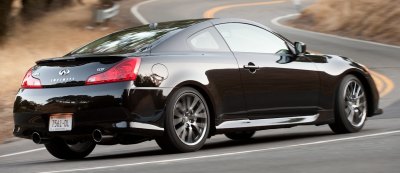
|
Launching IPL in this way could be
disastrous...
|
Rest of the tuning is equally modest:
aftermarket-like aero kits, slightly stiffer springs and dampers, new
wheels shod with different tires (though at the same sizes). All these
made up a little bit sportier driving experience at minimal price
increase. So what does Nissan America want to do with IPL ? a
half-hearted performance brand never sells. If it wants to build the
IPL a real performance brand, then launching the nameplate in this way
could be disastrous.
|
| The
above report was last updated on 11 Oct 2010. All Rights Reserved. |
| Specifications
|
| General remarks |
| Layout |
| Chassis |
| Body |
| Length / width / height |
| Wheelbase |
| Engine |
| Capacity |
| Valve gears |
| Induction |
| Other engine features |
| Max power |
| Max torque |
| Transmission |
Suspension layout
|
| Suspension features |
Tires
|
| Kerb weight |
| Top speed |
| 0-60 mph (sec) |
| 0-100 mph (sec) |
|
Infiniti
G35 Sport
|
Front-engined, RWD
|
| Steel monocoque |
| Mainly steel |
| 4750 / 1773 / 1453 mm |
| 2850 mm |
V6, 60-degree
|
| 3498 cc |
DOHC 24 valves, DVVT
|
| - |
| - |
| 305 hp / 6800 rpm |
| 268 lbft / 5200 rpm |
| 6-speed manual |
All multi-link
|
| - |
F: 225/50WR18
R: 245/45WR18
|
| 1625 kg |
| 155 mph (limited) |
5.5* / 5.4**
|
13.8* / 13.5**
|
|
Infiniti G37 Sport
|
Front-engined, RWD
|
| Steel monocoque |
| Mainly steel |
| 4750 / 1773 / 1453 mm |
| 2850 mm |
V6, 60-degree
|
| 3696 cc |
DOHC 24 valves, DVVT, VVL
|
| - |
| - |
| 330 hp / 7000 rpm |
| 269 lbft / 5200 rpm |
| 6-speed manual |
All multi-link
|
| - |
F: 225/50WR18
R: 245/45WR18
|
| 1680 kg |
| 155 mph (limited) |
5.2*
|
12.8*
|
|
Infiniti G37 Coupe Sport
|
Front-engined, RWD
|
| Steel monocoque |
| Mainly steel |
| 4650 / 1824 / 1395 mm |
| 2850 mm |
V6, 60-degree
|
| 3696 cc |
DOHC 24 valves, DVVT, VVL
|
| - |
| - |
| 330 hp / 7000 rpm |
| 269 lbft / 5200 rpm |
| 6-speed manual |
All multi-link
|
| - |
F: 225/45WR19
R: 245/40WR19
|
| 1663 kg |
| 155 mph (limited) |
5.3*
|
13.2*
|
|
|
|
|
|
| General remarks |
| Layout |
| Chassis |
| Body |
| Length / width / height |
| Wheelbase |
| Engine |
| Capacity |
| Valve gears |
| Induction |
| Other engine features |
| Max power |
| Max torque |
| Transmission |
Suspension layout
|
| Suspension features |
Tires
|
| Kerb weight |
| Top speed |
| 0-60 mph (sec) |
| 0-100 mph (sec) |
|
Infiniti IPL G Coupe
|
Front-engined, RWD
|
| Steel monocoque |
| Mainly steel |
| 4700 / 1824 / 1395 mm |
| 2850 mm |
V6, 60-degree
|
| 3696 cc |
DOHC 24 valves, DVVT, VVL
|
| - |
| - |
| 348 hp / 7400 rpm |
| 276 lbft / 5200 rpm |
| 6-speed manual |
All multi-link
|
| - |
F: 225/45WR19
R: 245/40WR19
|
| 1687 kg |
| 155 mph (limited) |
5.4*
|
12.9*
|
|
Infiniti G25
|
Front-engined, RWD
|
| Steel monocoque |
| Mainly steel |
| 4750 / 1773 / 1453 mm |
| 2850 mm |
V6, 60-degree
|
| 2496 cc |
DOHC 24 valves, DVVT
|
| - |
| - |
| 218 hp / 6400 rpm |
| 187 lbft / 4800 rpm |
| 7-speed automatic |
All multi-link
|
| - |
225/55R17
|
| 1600 kg |
| 155 mph (limited) |
7.5* / 7.5***
|
19.3* / 19.1***
|
|
|
|
| Performance
tested by: *C&D,
**R&T |
Copyright©
1997-2012
by Mark Wan @ AutoZine
|
|
|
 4
years after launch, Nissan Skyline / Infiniti G35 has received a major
update and a new codename V36. This update concentrates on 3 areas: 1)
power, 2)
handling and 3) interior quality. The objective is to close the gap
from class-leader BMW 3-Series.
4
years after launch, Nissan Skyline / Infiniti G35 has received a major
update and a new codename V36. This update concentrates on 3 areas: 1)
power, 2)
handling and 3) interior quality. The objective is to close the gap
from class-leader BMW 3-Series. Okay,
refinement is not the strongest suit of Skyline / G35, old or new. Its
trump card is driver appeal instead. This must thanks to the strong
engine and strong chassis. Nissan has updated the VQ series engine to
the 4th generation. Now codenamed VQ35HR – in which the HR represents
High Revolution – it can spin to 7500 rpm, up from 6600 rpm. This is
contributed by the addition of exhaust VVT (continuous type and
actuated by electromagnetic like Lexus LS460), smoother exhaust and
higher 10.6:1 compression made possible by improved knock control and
water cooling. The result is 306 horsepower at 6800 rpm, same value as
Lexus IS350, and a max torque of 268 lbft available at 5200 rpm. The
latter is not as brilliant as Lexus though. Infiniti claims lower fuel
consumption than the outgoing car, but you won't expect much
improvement because this engine still comes without direct injection.
Okay,
refinement is not the strongest suit of Skyline / G35, old or new. Its
trump card is driver appeal instead. This must thanks to the strong
engine and strong chassis. Nissan has updated the VQ series engine to
the 4th generation. Now codenamed VQ35HR – in which the HR represents
High Revolution – it can spin to 7500 rpm, up from 6600 rpm. This is
contributed by the addition of exhaust VVT (continuous type and
actuated by electromagnetic like Lexus LS460), smoother exhaust and
higher 10.6:1 compression made possible by improved knock control and
water cooling. The result is 306 horsepower at 6800 rpm, same value as
Lexus IS350, and a max torque of 268 lbft available at 5200 rpm. The
latter is not as brilliant as Lexus though. Infiniti claims lower fuel
consumption than the outgoing car, but you won't expect much
improvement because this engine still comes without direct injection.  The
chassis has received 40 percent increase of rigidity thanks to more
spot welding and laser seam welding. The stiffer chassis allows firmer
spring and damper setting, especially in G35 Sport. Front and rear
tracks have been widened slightly. Front to rear balance remains 53:47,
but the engine is now mounted 15mm lower. New viscous coupling limited
slip differential helps hard cornering. Besides, the Skyline has 4WS
(4-wheel-steering) returned as optional equipment, which steer the rear
wheels by up to 1 degree according to steering input and speed.
However, the benefit of 4WS is not obvious according to road testers.
The
chassis has received 40 percent increase of rigidity thanks to more
spot welding and laser seam welding. The stiffer chassis allows firmer
spring and damper setting, especially in G35 Sport. Front and rear
tracks have been widened slightly. Front to rear balance remains 53:47,
but the engine is now mounted 15mm lower. New viscous coupling limited
slip differential helps hard cornering. Besides, the Skyline has 4WS
(4-wheel-steering) returned as optional equipment, which steer the rear
wheels by up to 1 degree according to steering input and speed.
However, the benefit of 4WS is not obvious according to road testers. When Nissan introduced the pre-production
G37 Coupe to the press in March 2007, it brought a BMW 335i Coupe for
them to compare side by side on a test track. Until then, 335i was the
benchmark of the class and nobody else could come close to its perfect
combination of performance, handling and refinement. Apparently, Nissan
was confident to beat the great BMW, otherwise it would not have
brought the car there. In the end of the day, none of the American
journalists came home without praising the G37 and declaring it beating
the 335i.
When Nissan introduced the pre-production
G37 Coupe to the press in March 2007, it brought a BMW 335i Coupe for
them to compare side by side on a test track. Until then, 335i was the
benchmark of the class and nobody else could come close to its perfect
combination of performance, handling and refinement. Apparently, Nissan
was confident to beat the great BMW, otherwise it would not have
brought the car there. In the end of the day, none of the American
journalists came home without praising the G37 and declaring it beating
the 335i.  On
paper, the Infiniti has everything to beat the BMW. Its chassis is
lower and wider, suggesting better handling. If that's not enough, it
has bigger brakes inside the larger 19-inch wheels, a limited slip
differential and optional electronic-controlled 4-wheel-steering
(4WAS). It has an advantage of 30 horsepower and, ridiculously, its
high-revving naturally aspirated V6 conforms to the traditional
philosophy of BMW more than the twin-turbo six of 335i. In other words,
more BMW than BMW.
On
paper, the Infiniti has everything to beat the BMW. Its chassis is
lower and wider, suggesting better handling. If that's not enough, it
has bigger brakes inside the larger 19-inch wheels, a limited slip
differential and optional electronic-controlled 4-wheel-steering
(4WAS). It has an advantage of 30 horsepower and, ridiculously, its
high-revving naturally aspirated V6 conforms to the traditional
philosophy of BMW more than the twin-turbo six of 335i. In other words,
more BMW than BMW. Other
aspects are similar. While it matches 335i for body control and comes
very close in ride quality, most of its controls lack the fine
polishing of BMW – the steering feels numb, the gearshift is a little
notchy, the clutch
too heavy and abrupt, the brake feels vague and braking performance is
no where as good as the lighter BMW. These qualities separate a
fine car from a great car. Turn into corners, the G37
understeers a little more than the BMW as well as its predecessor
G35 Coupe. It becomes more civilized and, inevitably, delivers less fun.
Other
aspects are similar. While it matches 335i for body control and comes
very close in ride quality, most of its controls lack the fine
polishing of BMW – the steering feels numb, the gearshift is a little
notchy, the clutch
too heavy and abrupt, the brake feels vague and braking performance is
no where as good as the lighter BMW. These qualities separate a
fine car from a great car. Turn into corners, the G37
understeers a little more than the BMW as well as its predecessor
G35 Coupe. It becomes more civilized and, inevitably, delivers less fun. Can
the optional 4WAS system save it from losing ? Sadly, Nissan's
engineers forgot how to make a 4-wheel-steering system work like the
old Skyline GT-R. In the G37, the system actually introduces even more
understeer and makes the steering more unpredictable. In other words,
it is a waste of money.
Can
the optional 4WAS system save it from losing ? Sadly, Nissan's
engineers forgot how to make a 4-wheel-steering system work like the
old Skyline GT-R. In the G37, the system actually introduces even more
understeer and makes the steering more unpredictable. In other words,
it is a waste of money.  Following
Infiniti G37 Coupe, the sedan
version has also been upgraded to 3.7-liter engine, hence a new
designation G37. This version also signals the first wave of Infiniti
invasion into European market. At the moment of writing, the Japaense
Skyline sedan has not been updated yet. However, there is no reasons to
offer two different engines to different markets, so we expect Skyline
will also get the 3.7 upgrade soon.
Following
Infiniti G37 Coupe, the sedan
version has also been upgraded to 3.7-liter engine, hence a new
designation G37. This version also signals the first wave of Infiniti
invasion into European market. At the moment of writing, the Japaense
Skyline sedan has not been updated yet. However, there is no reasons to
offer two different engines to different markets, so we expect Skyline
will also get the 3.7 upgrade soon. 
